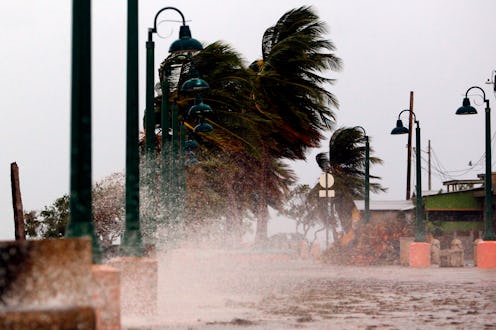
With Hurricane Harvey and Hurricane Irma out of the way, we have yet another Atlantic season storm barreling forward known as Hurricane Maria. According to meteorologists, Maria began as a Category 1 storm and rapidly intensified to a Category 5. On Monday evening, it made landfall on Dominica, a small Caribbean island, where its effect was described as disastrous and life-threatening. After devastating Dominica, Hurricane Maria headed toward Puerto Rico and the Virgin Islands. If you want to keep track of its path, here's how you can watch Hurricane Maria in real time.
EarthCam is a website that gives update visual content on various cities, states, and countries around the world. The website describes itself as a "virtual window to the world" that allows viewers to virtually tour popular landmarks and locations around the globe. But it isn't just tourist spots that the website gives you a glance into, you can also keep track of weather updates by watching its "extreme weather" segment.
Fair warning, though, the cameras located in the American regions of Puerto Rico and the Virgin Islands are showing up blank as the severity of the hurricane may have blocked signals. But you can check the website periodically to see if the video is back online. In addition to EarthCam, you can also track Hurricane Maria's wind flow by checking this map populated with data from the Global Forecast System.
At this moment, the National Hurricane Center has described Hurricane Maria as a Category 3 storm on the Saffir-Simpson hurricane wind scale. The devastating hurricane made landfall in Yabucoa in Puerto Rico on Wednesday packing winds at 155 mph but the hurricane was much stronger and intimidating for the Virgin Islands where it hit the region in the form of a Category 5 storm.
Hundreds of thousands of people have been relocated to find refuge from the hurricane in both regions. The NHS warned locals that Hurricane Maria will cause a "dangerous storm surge accompanied by large and destructive waves" and further noted that such waves "will raise water levels by as much as 10 to 15 feet above normal tide levels in [...] area near and to the north of the center of Maria for both the Southeastern Bahamas and the Turks and Caicos Islands."
It isn't just floodwater that is expected to overwhelm the locals in the specified regions; winds, too, are predicted to cause significant damage to infrastructure in the targeted areas. An alert from the National Weather Service noted that the hurricane could produce extremely intense and dangerous elevated winds that could cause electricity outages in residential and commercial areas.
Given the extremity of Maria's winds and predicted trajectory, the NHC made sure that its warning against the hurricane were loud and clear. While addressing the public, the NHC announced that because of Hurricane Maria "life-threatening flash floods and mudslides from heavy rainfall are expected across the Leeward Islands, including Puerto Rico and the U.S. and British Virgin Islands."
This year's Atlantic hurricane season has been particularly overwhelming and it's understandable if you feel paralyzed by the overdose of information but the safest route to protecting yourself and your loved ones from the damages inflicted by a natural disaster is preparing and acting on time. That's the first and foremost advice weather experts and meteorologists give to people.
The NHC has shared a "Hurricane Preparedness" guide which offers essential tips on how to prepare before a hurricane arrives. If you are in the pathway of Hurricane Maria, you should give this handy guide a thorough and complete look and see how you can be more proactive about shielding yourself from its devastation.